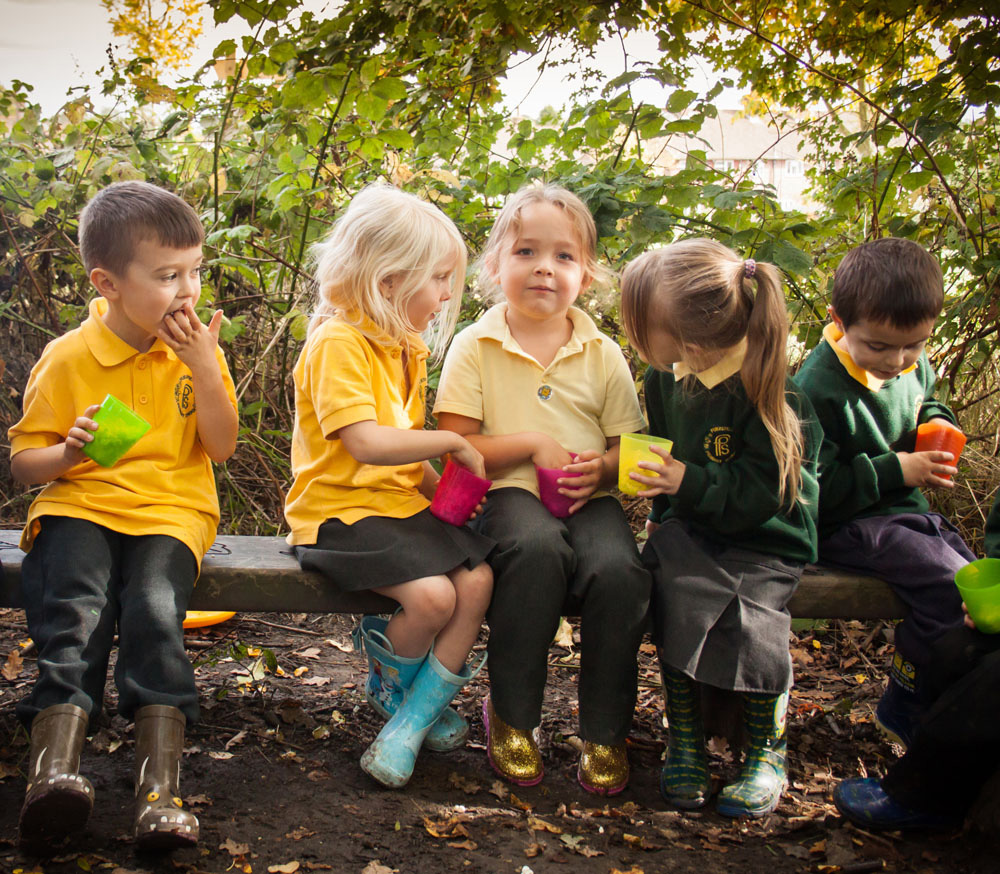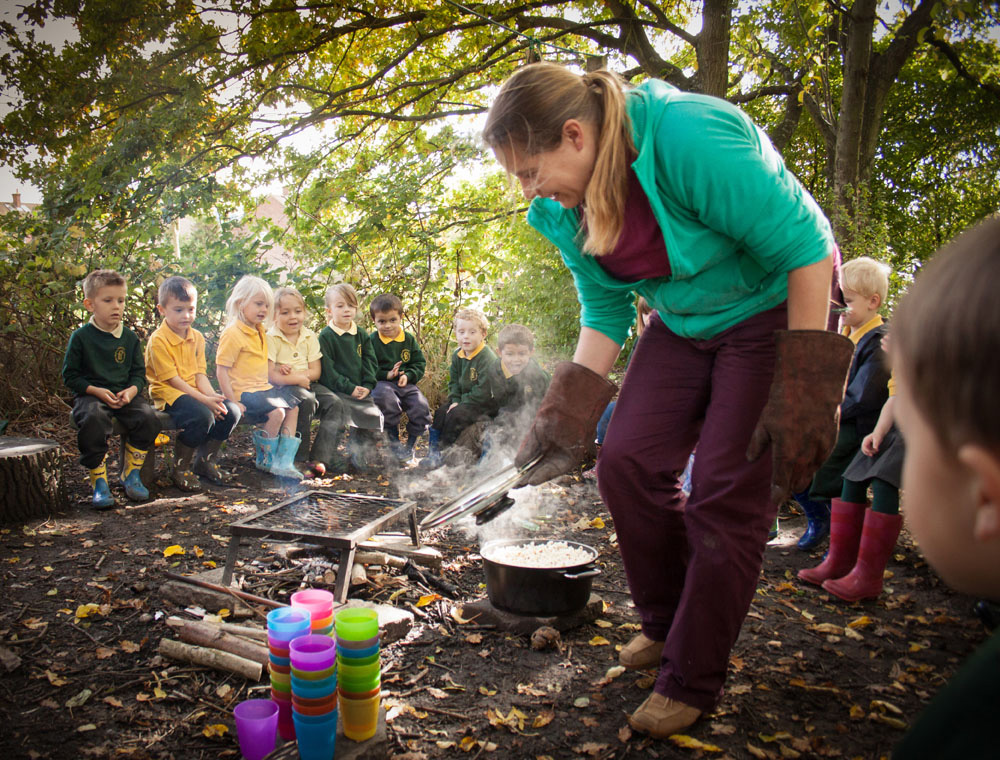Forest School
At Furzefield, all of our children benefit from Forest School provision. We have our own Forest School area and room on the school site and we also use nearby Furzefield Wood. Forest School activities are followed up in the classroom providing inspiration to help children develop their writing skills.
Our reception classes enjoy regular Forest School sessions. The activities are closely linked to the topic they are involved in at the time. We always make something to eat or drink on a campfire and there is time for children to enjoy free play and exploration.
All other year groups enjoy two units of Forest School sessions linked to another area of study. These also include campfire cooking and some time for self-directed play and exploration.
Some of examples of previously taught units are:
Year 1 – Our bodies and keeping healthy. This unit enhances the children’s learning in science about their bodies and how to stay healthy. The children also write simple recounts of their experiences in English. The children visit Furzefield Wood to make skeletons out of sticks, naming the bones in their bodies and use natural clay mud to create faces on trees. They sing songs and dance to reinforce the learning. At the school Forest School site, they create obstacle courses to challenge their bodies with different types of exercise and make and eat a healthy vegetable soup.
| Other National curriculum links | |
| Design and technology | Build structures, exploring how they can be made stronger, stiffer and more stable.
Use the basic principles of a healthy and varied diet to prepare dishes. Understand where food comes from. |
| Art | Use a range of materials creatively to design and make products.
Use drawing, painting and sculpture to develop and share their ideas, experiences and imagination. |
| Music | Use their voices expressively and creatively by singing songs and speaking chants and rhymes. |
| PE | Develop balance, agility and co-ordination, and begin to apply these in a range of activities.
Perform dances using simple movement patterns. |
Year 2 – The Frost Dragon. This unit enhances the children’s learning in English by providing inspiration for their creative writing. In this unit, the children discover ‘clues’ that there has been a dragon in the Forest School area. They use clay and other natural materials to make dragons or weave willow to make dragon wings. They also cook ‘dragon tails’, made from a simple sweet bread dough, over a campfire.
| Other National curriculum links | |
| Design and technology | Use the basic principles of a healthy and varied diet to prepare dishes.
Select from and use a wide range of materials and components, including construction materials, textiles and ingredients, according to their characteristics. |
| Art | Use a range of materials creatively to design and make products.
Use drawing, painting and sculpture to develop and share their ideas, experiences and imagination. |
Year 3 – Hercules Legends. This unit is linked to children’s learning in English and history about the Hercules Legends. It provides inspiration for creative writing as well as an opportunity to further explore two of the Hercules stories. In a session inspired by the story of Hercules and the Hydra, children make a giant, natural collage of the hydra and stinking ‘Hydra breath potions’, they then try an authentic Roman recipe for porridge with honey and cheese. In a session inspired by Hercules and the Golden Hind, children learn some nature awareness and tracking skills through games and exploration of Furzefield Wood.
| Other National curriculum links | |
| Art | Improve their mastery of art and design techniques, including drawing, painting and sculpture with a range of materials. |
| Design and technology | Select from and use a wider range of materials and components, including construction materials, textiles and ingredients, according to their functional properties and aesthetic qualities. |
| PE | Take part in outdoor and adventurous activity challenges both individually and within a team. |
Year 4 – The Ancient Mayans. This unit enhances the children’s learning in History through exploring aspects of ancient Mayan culture in a practical way. It also provides inspiration for recount writing in English. Children use cordage and feathers to create Mayan style headdresses, make artists charcoal and use it to decorate themselves with Mayan style ‘tattoos’ and they recreate, in miniature, two of the field systems the ancient Mayans used for farming. They also try a recipe made with the three staples of the ancient Mayan diet: beans, squash and corn.
| Other National curriculum links | |
| Art | Improve their mastery of art and design techniques, including drawing, painting and sculpture with a range of materials.
Produce creative work, exploring their ideas and recording their experiences. |
| Design and technology | Select from and use a wider range of materials and components, including construction materials, textiles and ingredients, according to their functional properties and aesthetic qualities. |
| Science | Set up simple practical enquiries, comparative and fair tests. |
Year 5 – Traditional Australian Stories. This unit enhances the children’s learning in geography as part of exploring Oceania and environmental issues using a traditional Australian story as the ‘hook’. Children collaborate in teams to write ‘song lines’ as a form of natural navigation; they carry out work to improve the environment of the Forest School area and use tools to make ‘bullroarers’. These are then used in a final ‘ceremony’ in which children send a message about how we can take better of our planet. Children also try some ‘bush tucker’ or wild food.
| Other National curriculum links | |
| Design and technology | Select from and use a wider range of tools and equipment to perform practical tasks [for example, cutting, shaping, joining and finishing], accurately. |
| PE | Take part in outdoor and adventurous activity challenges both individually and within a team. |
Year 6 – Hedgerow harvest and traditional games. This unit is linked to the children’s study of WWII in history and English. As part of their learning about rationing, the children learn that there are abundant sources of vitamin C in the hedgerows. They process hawthorn berries to make fruit leather. They also think about simple games that children played in the past; they explore different ways of ‘curing’ conkers to make them stronger and have a conker competition.
| Other National curriculum links | |
| Design and technology | Understand and apply the principles of a healthy and varied diet.
Prepare and cook a variety of dishes using a range of cooking techniques. Understand seasonality, and know where and how a variety of ingredients are grown, reared, caught and processed. |
| PE | Enjoy communicating, collaborating and competing with each other. |
| Science | Carry out comparative and fair tests.
Draw conclusions based on their data and observations, use evidence to justify their ideas, and use their scientific knowledge and understanding to explain their findings. |
Safety at Forest School
School Safety is very important at Forest School.
- Clear safety procedures are in place
- Activities are carefully risk assessed
- Forest School leaders are trained in first aid in an outdoor setting
- Children are closely supervised
What are the benefits?
- It builds children’s confidence and self-esteem as they are responsible for making their own decisions and are carefully supported to achieve this
- It supports all areas of the curriculum in an exciting, hands-on way
- It develops communication and social skills. It develops knowledge, skills, interests and understanding through practical, hands-on experiences
- Children enjoy meeting and overcoming challenges at their own pace




